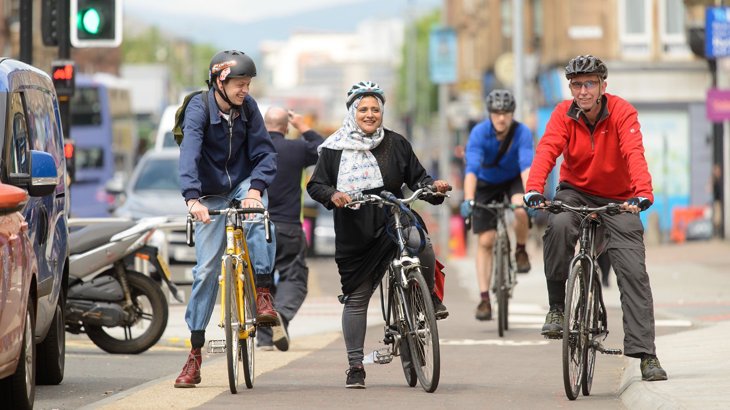Change is never easy. But as we work together to face the twin challenges of the pandemic and the climate crisis, conversations around how we make change will need to remain positive. After a particularly difficult week, our Director of Urbanism, Daisy Narayanan reflects on how crucial it is for our public discourse to be civil and our online and physical environments to be safe, if we are to make meaningful change.

It hasn’t been the easiest of weeks, so forgive me if this is an angry blog.
Last Thursday, as I was starting to wind down from work and look ahead to a few days of family time, I got a message from a dear friend about a few tweets circulating on social media.
An anonymous Twitter account, known for their relentlessly vitriolic posts, had shared photographs of me (or someone they claimed was me) cycling at night, along a street close to where I live.
I didn’t expect how terrified that made me feel and the next few hours were spent in a blur: "Did they follow me home? Do they know who my children are? Am I safe?"
Challenging the status quo
Make no mistake, I am no stranger to online bullying and vitriol.
As most people who try to make positive change and who try to challenge the status quo will attest, social media can be a vicious place.
And as a woman, (and heaven forbid - a woman of colour!), I have found myself, at times, to be a magnet for some, particularly strange views.
In 2018, when the City of Edinburgh Council announced that I would be joining them on secondment from Sustrans for a year, to lead the Edinburgh City Centre Transformation project, I made the mistake of reading the comments underneath a newspaper article.
It was a real glimpse, right at the very outset, of the vitriol directed at public officials and elected members, working in difficult, unforgiving environments.
Since then, there have been more than a few hurtful words that have come my way, mainly by anonymous keyboard warriors.
Making fun of my ‘hippy-dippy’ name? Check.
Racism? Apparently ‘Indian Daisy’ is out to destroy Edinburgh.
Let us throw in a little bit of misogyny into the mix. ‘It or Her’ is responsible for transport policy.
Threats of violence? ‘..needs to be taken up against a wall and shot...’
Oh yes, that last one did get taken down by Twitter.
Being neither a council official nor a politician with any kind of power to set policy in this city, I have never ceased to be astounded at the level of vitriol that comes my way.
But I consider myself a strong and resilient person and am able to shake off a lot of this venom.
I do occasionally, gently and with (gritted-teeth) humour, call it out publicly.
I am also fortunate to be able to focus on the positive and wonderful people that I work and collaborate with and those who reinforce how positive the social media space can be.
I have talked often, publicly, about my relentless optimism.
Why this time felt different
So why then did this incident feel so different? Why did I find myself unable to sleep with worry?
Why did I find myself, on my son’s tenth birthday, walking up Calton Hill sobbing on the phone to a friend?
And then the rest of the afternoon apologising to my friends who this troll had interacted with and brought into the cesspool of vitriol?
It feels different because the line between the online space and the physical environment around me has been breached.
And let us be honest, neither of those spaces is particularly kind to women.
I am no longer upset or scared. I have taken strength from the wave of kindness and messages of support that have come my way.
And I genuinely believe that there is far more light than darkness out in the world.
Is safety too much to ask for?
However, I am angry. I am angry because so many women who reached out to me said that they have had similar experiences. That they too have felt stalked and intimidated.
So many women have reached out to me to say that they understand why I would protect my social media account and use it sparingly - why would you put yourself ‘out there’, make yourself more vulnerable, physically and emotionally?
So many women have reached out to say that they have used the street featured in the photographs, on their bicycles, putting their personal safety above any other consideration.
Safety. Is that too much to ask for – whether online or on our town and city streets?
Research shows that for many women personal safety is a barrier that contributes to their mobility especially travelling at night.
We must do better. If we want to ensure that vulnerable voices are part of the conversation, part of shaping a new future, we must collectively make it easier for those voices to be heard.
And to feel safe doing so.
Sustrans works to ensure cycling and walking is inclusive and helps address wider inequality within cities and towns.
We want to help make cycling and walking attractive, safe and accessible to everyone.
Read some of our latest reports:





